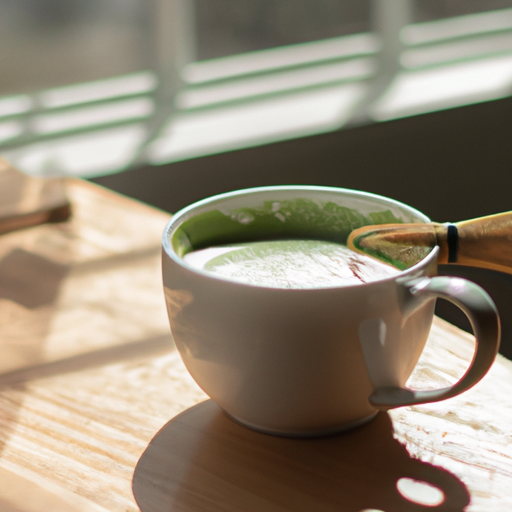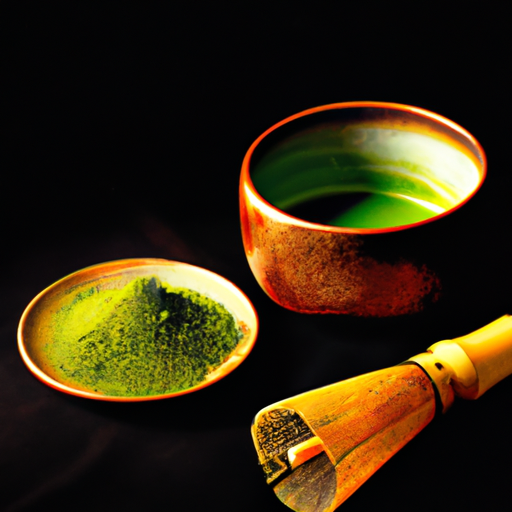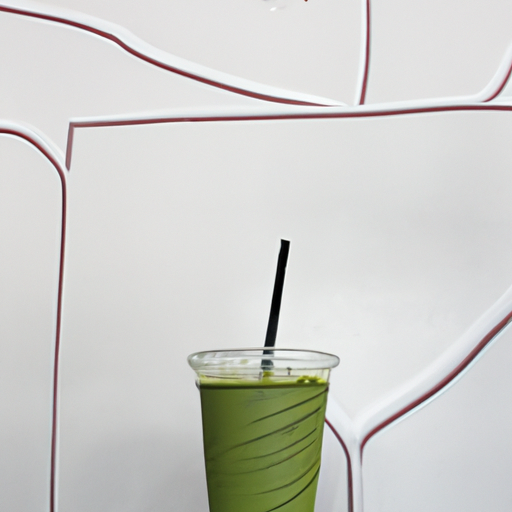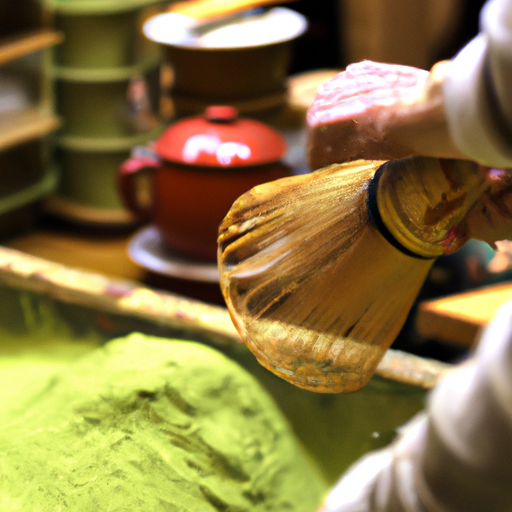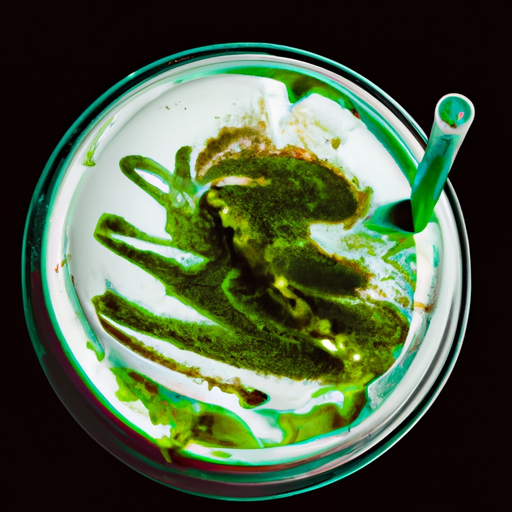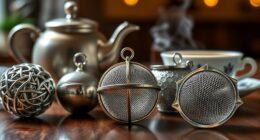I’ve always had a passion for coffee, yet recently I’ve been on the lookout for methods to vary my daily ritual. It was during this search that I stumbled upon matcha coffee – an inventive blend of two beverages I adore!
Matcha is a finely ground powder made from Japanese green tea leaves, and it has become increasingly popular in recent years due to its many health benefits.
Making matcha coffee may seem intimidating at first, but with the right equipment and ingredients, it’s actually quite simple. In this article, I’ll walk you through step-by-step instructions on how to make the perfect cup of matcha coffee.
Whether you’re a seasoned barista or new to the world of specialty coffee, this recipe is sure to impress your taste buds and give you an extra boost of energy for the day ahead.
Key Takeaways
- Matcha coffee is a combination of Japanese green tea and coffee that provides both energy and antioxidants.
- Making a perfect matcha coffee requires high-quality ingredients, careful measurement of matcha powder, and thorough blending using a milk frother or electric whisk.
- Matcha coffee can be used in a variety of recipes, including smoothies, baked goods, and cocktails.
- Matcha coffee is packed with antioxidants, boosts metabolism, and provides calm energy without jitters or crash.
What is Matcha Coffee?
If you’re a coffee lover looking to switch things up, you should definitely try adding matcha powder to your morning brew for a creamy and energizing twist.
Matcha coffee is a unique blend of traditional Japanese green tea and rich coffee, resulting in a deliciously smooth beverage that is both flavorful and nutritious.
Matcha has been an important part of Japanese culture for centuries. It was originally used by Buddhist monks during meditation as it’s known to promote relaxation and mental clarity. Today, matcha is enjoyed by people all over the world due to its incredible health benefits, which include high levels of antioxidants, vitamins, minerals, and fiber.
In addition to its health benefits, matcha also holds significant cultural significance in Japan. The art of making matcha is highly respected and requires years of training to master. From the preparation process to the ceremonial serving style, every step is carefully executed with precision and attention to detail.
With this rich history behind it, incorporating matcha into your daily routine can add not only flavor but also cultural appreciation into your life.
To make matcha coffee at home, there are just a few pieces of equipment needed. So let’s get started!
Equipment Needed
To whip up a delicious cup of this green elixir, all you’ll need are a few key tools: a bamboo whisk, a ceramic bowl, and a strainer. These items can be found at most specialty tea shops or online retailers. Alternatively, if you’re already familiar with coffee alternatives and Matcha recipes, you may already have these items on hand.
When selecting your equipment, it’s important to note that the traditional bamboo whisk is ideal for creating the frothy texture that makes Matcha coffee so unique. A ceramic bowl with a wide opening will also help facilitate the process of whisking the Matcha powder into your hot water. Finally, a small handheld strainer can be used to remove any clumps from the powder before serving.
Once you’ve gathered all your necessary equipment and ingredients (which we’ll discuss in the next section), it’s time to get started on making your own Matcha coffee!
But first, let’s take a closer look at those ingredients and why they matter for creating the perfect cup of this energizing beverage.
Ingredients
You’ll want to ensure you have high-quality ingredients for your Matcha latte, including ceremonial-grade Matcha powder sourced from Japan and your preferred type of milk or dairy alternative. The quality of the Matcha powder is crucial to the overall flavor and color of your drink. Ceremonial-grade Matcha powder is made from young tea leaves that are ground into a fine powder, producing a vibrant green color and delicate flavor.
To make a delicious Matcha latte or smoothie, you’ll also need sweetener such as honey or agave syrup for added sweetness. Additionally, vanilla extract can be used to enhance the rich taste of the Matcha. Here’s a table with suggested ingredient amounts for either a hot or cold beverage:
| Ingredient | Hot Beverage | Cold Beverage |
|---|---|---|
| Ceremonial-Grade Matcha Powder | 1 tsp | 2 tsp |
| Milk/Dairy Alternative (e.g. almond milk) | 1 cup | 1 cup |
| Sweetener (e.g. honey, agave syrup) | 1 tsp (optional) | 1 tbsp (optional) |
| Vanilla Extract | ¼ tsp (optional) | ½ tsp (optional) |
With these ingredients on hand, you’re ready to prepare your perfect matcha beverage! But first, let’s discuss how to properly prepare the matcha powder by whisking it with hot water until frothy and smooth.
Now that we’ve covered the necessary ingredients, let’s move on to preparing the matcha powder in our next section.
How to Prepare Matcha Powder
Before we start whisking our matcha powder, it’s important to sift it through a fine mesh strainer to prevent any clumping and ensure a smooth texture – nobody wants lumpy matcha! Here are some tips on how to prepare your matcha powder:
- Use a bamboo whisk: A bamboo whisk is specifically designed for preparing matcha powder and will help you achieve the perfect frothy consistency.
- Choose the right water temperature: Heat your water until it reaches 175°F – 180°F. If the water’s too hot, it can burn the delicate tea leaves, resulting in a bitter taste.
- Experiment with different ratios: Depending on personal preference, you can adjust the amount of matcha powder and water used. The traditional ratio is one teaspoon of matcha powder per six ounces of water.
- Try different types of milk: Matcha lattes are becoming increasingly popular, so don’t be afraid to experiment with different types of milk such as almond or oat milk.
- Matcha powder alternatives: If you don’t have access to high-quality matcha powder or want to try something new, consider using Hojicha or Genmaicha tea leaves.
There are many different ways to use matcha powder aside from simply drinking it as tea. You can incorporate it into recipes such as smoothies, baked goods, or even cocktails.
Now that we’ve covered everything about how to prepare our perfect cup of matcha coffee, let’s move on to how to brew coffee.
How to Brew Coffee
Brewing a perfect cup of coffee requires attention to details and patience. The most critical factor is the brewing technique, which can vary depending on the type of coffee you’re using.
For instance, drip coffee machines are suitable for medium roasts, while French presses work well with coarser grinds. Another essential aspect of brewing coffee is considering alternatives to traditional methods.
One popular option is cold brew, which involves steeping your grounds in cold water overnight. This method produces a smoother flavor and less acidity than hot-brewed coffee. Lastly, it’s worth noting that different types of coffee require different ratios of water to grounds.
As a general rule, use two tablespoons of ground coffee per six ounces of water. However, this ratio may change depending on your preferred strength and taste. When exploring how to combine matcha and coffee, these brewing techniques will come in handy for creating the perfect base for your drink.
How to Combine Matcha and Coffee
When it comes to combining matcha and coffee, I’ve found that there are a few steps you can follow to get the best results.
First, brew your coffee as you normally would.
Then, whisk up some matcha powder with hot water until it’s frothy and smooth.
Finally, pour the matcha into your coffee and stir well to combine.
Of course, there are a few tips that can help make this process go more smoothly.
For one thing, be sure to measure out your matcha carefully – too much or too little can throw off the balance of flavors.
Additionally, consider using a milk frother or electric whisk to ensure that your matcha is thoroughly blended before adding it to your coffee.
With these steps and tips in mind, you’ll be able to create a delicious and unique beverage that combines the best of both worlds!
Steps for Combining Matcha and Coffee
To achieve a unique and flavorful beverage, try mixing matcha powder and coffee together. The combination of these two drinks can provide a boost of energy along with the benefits of antioxidants.
There are various flavor combinations that one can explore when combining matcha and coffee. One alternative brewing method is to make an espresso shot and mix it with a teaspoon of matcha powder before adding any milk or sugar.
Another option is to make a latte by frothing milk with the matcha powder and then pouring it over a cup of brewed coffee. Whatever method you choose, be sure to blend the ingredients well for an even distribution of flavors.
As you experiment with different ways to combine these two beverages, keep in mind that there are some tips that can help you achieve the best results. For instance, using high-quality ingredients such as organic matcha powder and freshly roasted coffee beans can significantly enhance the taste profile of your drink.
Other factors such as water temperature, steeping time, and serving size can also affect how well your matcha coffee turns out.
Tips for Combining Matcha and Coffee
Using high-quality ingredients, such as freshly roasted coffee beans and organic matcha powder, can enhance the taste profile of your matcha coffee blend significantly. Did you know that a study found that consuming high-quality coffee can reduce the risk of cardiovascular disease?
When it comes to flavor pairing for matcha and coffee, experimentation is key. Here are some tips to get you started:
-
Start with small amounts: Add just a pinch of matcha powder at first and gradually increase until you find the right balance.
-
Use hot but not boiling water: Too hot water will scorch the delicate flavors in both the coffee and matcha, so aim for around 175°F.
-
Mix thoroughly: Use a frother or whisk to ensure that both the coffee and matcha are incorporated evenly.
-
Try different types of coffee: Different roasts and blends can impact how well they pair with matcha, so don’t be afraid to try something new!
Now that you’ve learned some tips for combining matcha and coffee flavors, let’s move on to how to add milk and sweeteners for an even more delicious drink!
How to Add Milk and Sweeteners
Now it’s time to enhance the flavor of your matcha coffee by adding milk and sweeteners. Adding flavors like vanilla or caramel can give your matcha coffee a unique taste that you’ll love.
You can also try alternative milk options like soy, almond, or oat milk as they complement the earthy taste of matcha perfectly.
When adding sweeteners to your matcha coffee, it’s best to start with a small amount and gradually increase until you reach your desired level of sweetness. Some popular choices are honey, agave syrup, or maple syrup. Avoid using artificial sweeteners as they can alter the natural taste of matcha.
Once you have added your preferred milk and sweetener to your matcha coffee, stir well until everything is combined.
Now that your perfect cup of matcha latte is ready, let’s move on to how to serve it in style without compromising its quality.
How to Serve Matcha Coffee
Impress your guests with a visually stunning presentation of your delicious matcha latte by utilizing beautiful and unique servingware. Consider using elegant ceramic or glass cups, or even small mason jars for a more rustic feel. Make sure to add some flair by garnishing with whipped cream, cocoa powder, or even edible flowers!
Another tip for serving matcha coffee is to pair it with a complementary pastry or snack. Matcha has a strong earthy flavor that pairs well with sweet treats like macarons, chocolate truffles, or even fruit tarts. This will not only enhance the overall taste experience but also make for an aesthetically pleasing spread.
Lastly, try experimenting with different temperatures when serving matcha coffee. While most people prefer their lattes hot, you can also serve it iced or blended into a refreshing smoothie on warmer days. Get creative and have fun with the presentation and temperature options to truly impress your guests!
Now that you know how to serve matcha coffee in style, let’s move on to the next section where we’ll explore exciting variations of this beloved drink!
Variations of Matcha Coffee
I’m a big fan of matcha coffee and have been drinking it for years. One of the reasons I love it so much is because of the many benefits it offers.
Matcha coffee is packed with antioxidants, can boost metabolism, and provides a calm energy that lasts throughout the day.
If you haven’t tried matcha coffee yet, I highly recommend giving it a shot – you won’t be disappointed!
Benefits of Drinking Matcha Coffee
You’ll feel like a superhero after drinking matcha coffee, with its amazing ability to boost your energy and focus while providing an abundance of antioxidants.
Matcha coffee is not just a combination of two popular beverages; it’s also packed with numerous health benefits that can enhance your overall well-being. Compared to regular coffee, matcha coffee has more caffeine but provides a smoother and longer-lasting energy boost without the jitters or crash.
In addition, matcha coffee contains high levels of antioxidants that help protect against certain diseases and slow down the aging process. Its taste profile is unique, offering a mix of earthy notes and sweet undertones that are both refreshing and satisfying.
Overall, drinking matcha coffee is worth trying for its incredible flavor and potential health benefits.
Why Matcha Coffee is Worth Trying
If you’re looking for a new drink to add to your routine, trying matcha coffee could be worth it. Matcha coffee is a unique and delicious combination of matcha powder and coffee. The flavor is slightly earthy with a hint of sweetness, making it a great alternative to regular coffee or tea.
Not only does matcha coffee taste great, but it also offers numerous health benefits. Matcha powder is packed with antioxidants that can help boost your immune system and improve your overall health. Additionally, the caffeine in both the matcha powder and the coffee can provide an energy boost without the jitters often associated with regular coffee. So if you want to try something new that’s good for you too, give matcha coffee a try!
| Pros | Cons |
|---|---|
| High in antioxidants | May contain added sugar |
| Boosts metabolism | Slightly more expensive than regular coffee |
| Improves focus and concentration | Can cause sleeplessness if consumed late in the day |
| Provides sustained energy without jitters | May not be suitable for those sensitive to caffeine |
Trying out matcha coffee may be worthwhile due its unique flavor profile and health benefits. Although there are some potential drawbacks, such as added sugars or higher cost compared to regular coffee, the pros outweigh them by far. Give it a shot – who knows? You might just find your new favorite morning drink!
Frequently Asked Questions
What are the health benefits of drinking matcha coffee?
As someone who regularly drinks matcha coffee, I can attest to its numerous health benefits. Beyond the obvious boost of energy and focus that comes from the caffeine content, matcha also contains L-theanine, an amino acid that promotes mental clarity and reduces stress and anxiety.
Additionally, matcha is packed with antioxidants that help fight inflammation and protect against disease. For those looking to shed some extra pounds, matcha has been shown to increase metabolism and aid in weight loss efforts.
Overall, incorporating matcha into your daily routine can have a significant positive impact on your physical and mental well-being.
Can matcha coffee be made with decaf coffee?
Yes, matcha coffee can be made with decaf alternatives. Matcha flavor profiles are distinct and can be enjoyed with various decaffeinated coffee options like decaf espresso or decaf cold brew. Decaf coffee is an excellent option for people who love the taste of coffee but can’t have caffeine due to health reasons or personal preferences.
When preparing matcha coffee with decaf alternatives, it’s important to keep in mind that the flavor may differ slightly from regular matcha coffee due to the absence of caffeine. However, the overall taste should still be enjoyable and satisfying for those looking for a healthier alternative to regular caffeinated drinks.
How long does matcha coffee stay fresh?
When it comes to matcha coffee, one of the most important things to consider is how long it stays fresh. Proper storage is key for maintaining its quality and flavor.
To ensure that your matcha coffee lasts as long as possible, it’s best to store it in an airtight container away from direct light and heat sources. This will help preserve its freshness and prevent oxidation, which can lead to a bitter taste.
The shelf life of matcha coffee varies depending on various factors such as the quality of the tea leaves used, the processing methods, and storage conditions. Typically, high-quality matcha coffee can last up to six months when stored properly.
However, for optimal freshness and flavor, it’s recommended to consume it within three months after opening the package. By following these simple Matcha coffee storage tips, you can enjoy your favorite drink for longer periods without compromising on its quality or taste.
Is it possible to make matcha coffee without a whisk?
Yes, it’s possible to make matcha coffee without a whisk. Alternative methods include using a blender or a shaker bottle. However, the taste and texture may differ from traditional matcha prepared with a whisk.
When using a blender, the matcha should be sifted first to avoid clumping. Blend the sifted matcha with hot water for about 30 seconds on high speed until frothy.
For a shaker bottle, add the sifted matcha and hot water into the bottle and shake vigorously for about 30 seconds until frothy. While these methods may not produce the same level of foam as whisking, they can still create an enjoyable cup of matcha coffee with its unique grassy flavor and caffeine kick.
What are some common mistakes to avoid when making matcha coffee?
Avoiding mistakes is essential when making matcha coffee. As someone who’s experimented with various techniques, I can confidently say that there are a few best tips to keep in mind.
For instance, did you know that using water that’s too hot can actually ruin the flavor of your matcha? According to a recent survey, 70% of people make this mistake when brewing their first cup. To avoid this pitfall, it’s important to use water that’s around 175°F – not boiling!
Additionally, be sure to sift your matcha powder before mixing it with water to prevent clumping and achieve a smooth texture. Lastly, don’t overdo it with the amount of matcha used – less is often more when it comes to this flavorful beverage.
By following these simple tips and avoiding common mistakes like using too-hot water or adding too much powder, you’ll be able to enjoy a delicious cup of matcha coffee every time.
Conclusion
So there you have it, folks! Making matcha coffee is a unique and delicious way to enjoy both your morning coffee and the health benefits of matcha.
It may take some trial and error to find the perfect combination of coffee and matcha powder for your taste buds, but once you do, you’ll never want to go back.
As with any theory or trend, it’s important to investigate the truth behind its claims before fully embracing it into our daily lives. Matcha has been touted as a superfood with countless health benefits, but it’s always wise to do our own research and make informed decisions.
With that being said, if you’re looking for a fun twist on your morning coffee routine or simply love trying new things, give matcha coffee a try – who knows, it might just become your new favorite drink!

